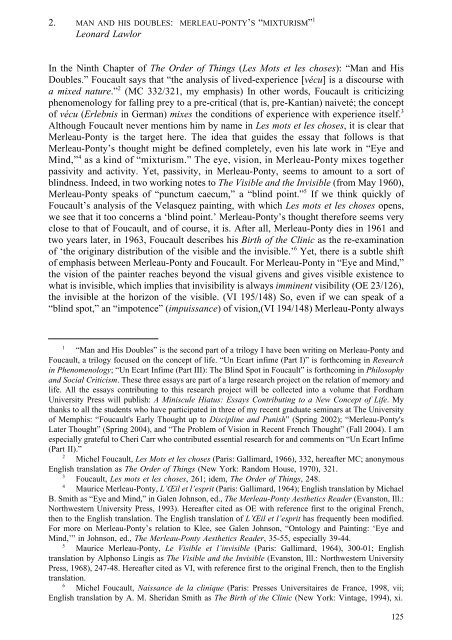[Andrzej_Wiercinski_(ed ... - WordPress.com
[Andrzej_Wiercinski_(ed ... - WordPress.com
[Andrzej_Wiercinski_(ed ... - WordPress.com
You also want an ePaper? Increase the reach of your titles
YUMPU automatically turns print PDFs into web optimized ePapers that Google loves.
2. MAN AND HIS DOUBLES: MERLEAU-PONTY’S “MIXTURISM” 1Leonard LawlorIn the Ninth Chapter of The Order of Things (Les Mots et les choses): “Man and HisDoubles.” Foucault says that “the analysis of liv<strong>ed</strong>-experience [vécu] is a discourse witha mix<strong>ed</strong> nature.” 2 (MC 332/321, my emphasis) In other words, Foucault is criticizingphenomenology for falling prey to a pre-critical (that is, pre-Kantian) naiveté; the conceptof vécu (Erlebnis in German) mixes the conditions of experience with experience itself. 3Although Foucault never mentions him by name in Les mots et les choses, it is clear thatMerleau-Ponty is the target here. The idea that guides the essay that follows is thatMerleau-Ponty’s thought might be defin<strong>ed</strong> <strong>com</strong>pletely, even his late work in “Eye andMind,” 4 as a kind of “mixturism.” The eye, vision, in Merleau-Ponty mixes togetherpassivity and activity. Yet, passivity, in Merleau-Ponty, seems to amount to a sort ofblindness. Inde<strong>ed</strong>, in two working notes to The Visible and the Invisible (from May 1960),Merleau-Ponty speaks of “punctum caecum,” a “blind point.” 5 If we think quickly ofFoucault’s analysis of the Velasquez painting, with which Les mots et les choses opens,we see that it too concerns a ‘blind point.’ Merleau-Ponty’s thought therefore seems veryclose to that of Foucault, and of course, it is. After all, Merleau-Ponty dies in 1961 andtwo years later, in 1963, Foucault describes his Birth of the Clinic as the re-examinationof ‘the originary distribution of the visible and the invisible.’ 6 Yet, there is a subtle shiftof emphasis between Merleau-Ponty and Foucault. For Merleau-Ponty in “Eye and Mind,”the vision of the painter reaches beyond the visual givens and gives visible existence towhat is invisible, which implies that invisibility is always imminent visibility (OE 23/126),the invisible at the horizon of the visible. (VI 195/148) So, even if we can speak of a“blind spot,” an “impotence” (impuissance) of vision,(VI 194/148) Merleau-Ponty always1“Man and His Doubles” is the second part of a trilogy I have been writing on Merleau-Ponty andFoucault, a trilogy focus<strong>ed</strong> on the concept of life. “Un Ecart infime (Part I)” is forth<strong>com</strong>ing in Researchin Phenomenology; “Un Ecart Infime (Part III): The Blind Spot in Foucault” is forth<strong>com</strong>ing in Philosophyand Social Criticism. These three essays are part of a large research project on the relation of memory andlife. All the essays contributing to this research project will be collect<strong>ed</strong> into a volume that FordhamUniversity Press will publish: A Miniscule Hiatus: Essays Contributing to a New Concept of Life. Mythanks to all the students who have participat<strong>ed</strong> in three of my recent graduate seminars at The Universityof Memphis: “Foucault's Early Thought up to Discipline and Punish” (Spring 2002); “Merleau-Ponty'sLater Thought” (Spring 2004), and “The Problem of Vision in Recent French Thought” (Fall 2004). I amespecially grateful to Cheri Carr who contribut<strong>ed</strong> essential research for and <strong>com</strong>ments on “Un Ecart Infime(Part II).”2Michel Foucault, Les Mots et les choses (Paris: Gallimard, 1966), 332, hereafter MC; anonymousEnglish translation as The Order of Things (New York: Random House, 1970), 321.3Foucault, Les mots et les choses, 261; idem, The Order of Things, 248.4Maurice Merleau-Ponty, L’Œil et l’esprit (Paris: Gallimard, 1964); English translation by MichaelB. Smith as “Eye and Mind,” in Galen Johnson, <strong>ed</strong>., The Merleau-Ponty Aesthetics Reader (Evanston, Ill.:Northwestern University Press, 1993). Hereafter cit<strong>ed</strong> as OE with reference first to the original French,then to the English translation. The English translation of L’Œil et l’esprit has frequently been modifi<strong>ed</strong>.For more on Merleau-Ponty’s relation to Klee, see Galen Johnson, “Ontology and Painting: ‘Eye andMind,’” in Johnson, <strong>ed</strong>., The Merleau-Ponty Aesthetics Reader, 35-55, especially 39-44.5Maurice Merleau-Ponty, Le Visible et l’invisible (Paris: Gallimard, 1964), 300-01; Englishtranslation by Alphonso Lingis as The Visible and the Invisible (Evanston, Ill.: Northwestern UniversityPress, 1968), 247-48. Hereafter cit<strong>ed</strong> as VI, with reference first to the original French, then to the Englishtranslation.6Michel Foucault, Naissance de la clinique (Paris: Presses Universitaires de France, 1998, vii;English translation by A. M. Sheridan Smith as The Birth of the Clinic (New York: Vintage, 1994), xi.125


